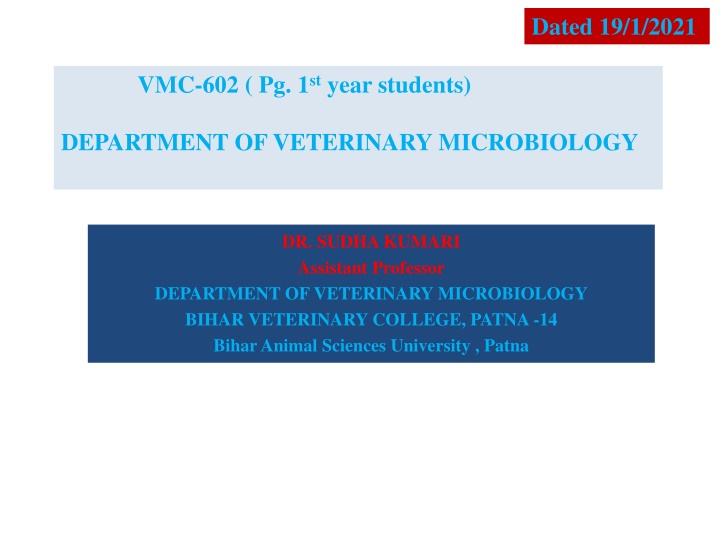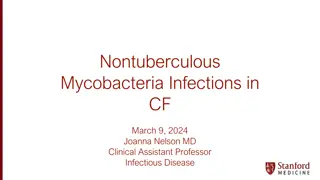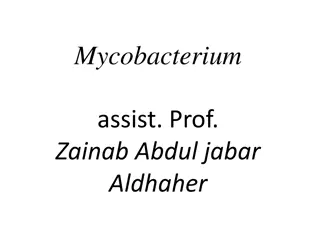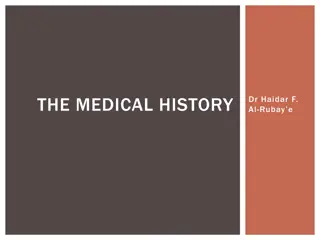
Mycobacteria: History and Characteristics
Mycobacterium tuberculosis, a significant pathogen, has a rich evolutionary history dating back millions of years. This article delves into the origins, characteristics, and pathogenicity of mycobacteria, highlighting their unique features such as their cell wall composition and intracellular pathogenic nature. Understanding the morphology and biology of mycobacteria is crucial in veterinary microbiology research and diagnosis.
Download Presentation

Please find below an Image/Link to download the presentation.
The content on the website is provided AS IS for your information and personal use only. It may not be sold, licensed, or shared on other websites without obtaining consent from the author. If you encounter any issues during the download, it is possible that the publisher has removed the file from their server.
You are allowed to download the files provided on this website for personal or commercial use, subject to the condition that they are used lawfully. All files are the property of their respective owners.
The content on the website is provided AS IS for your information and personal use only. It may not be sold, licensed, or shared on other websites without obtaining consent from the author.
E N D
Presentation Transcript
Dated 19/1/2021 VMC-602 ( Pg. 1st year students) DEPARTMENT OF VETERINARY MICROBIOLOGY DR. SUDHA KUMARI Assistant Professor DEPARTMENT OF VETERINARY MICROBIOLOGY BIHAR VETERINARY COLLEGE, PATNA -14 Bihar Animal Sciences University , Patna
Mycobacterium tuberculosis may have killed more persons than any other microbial pathogen. One can hypothesize that the genus Mycobacterium originated more than 150 million years ago. Mycobacterium ulcerans has specific habitat requirements and a current geographic distribution that separates its endemic regions widely. M. tuberculosis allow a more rigorous estimation of the time of origin of mycobacteria. This estimation is facilitated by the low mutation rate of M. tuberculosis.
Throughout history, the disease tuberculosis has been variously known as consumption, phthisis and the White Plague. It is generally accepted that the causative agent, Mycobacterium tuberculosis originated from other, more primitive organisms of the same genus Mycobacterium.
Mycobacteria Know :- Introduction, INTRODUCTION: Species, Mycobacteria is an obligate aerobe growing most successfully in tissues with a high oxygen content.(the upper lobe of the lung and the kidney). Morphology, Growth, Characteristics, Its cell wall contains several complex lipids ( long-chain fatty acids called mycolic acids). Biochemical reactions, It is relatively resistant to acids and alkalis. NaOH is used to concentrate clinical specimens; it destroys unwanted bacteria, human and animal cells, and mucus but not the organism. Pathogenicity and Virulence and Laboratory Diagnosis etc.
They are Facultative intracellular pathogens usually infecting mononuclear phagocytes (e.g. macrophages). The genera Mycobacterium and Nocardia have been grouped into the family mycobacteriaceae. They are characterized by the presence of long-chain fatty acids, called mycolic acids in their cell walls Mycobacteria are aerobic, slender, curved rods in stained clinical specimens. The cell wall is composed of mycolic acids, complex waxes and unique glycolipids.
Morphology : SHAPE - long, slender, straight or slightly curved rod. SIZE - 3 x 0.3 m Intracellular. Non sporing, non motile gram-positive, Bacteria are seen singly or in groups and lying free outside the cell. Organism are identified by their red colour on acid fast staining.
Acid-fast stain ACID FAST stain Gram stain
ACID FAST BACILLI: Mycobacteria are virtually the only bacteria that are acid-fast because of the presence of mycolic acid and their lipid-rich cell walls, which are relatively impermeable to various basic dyes unless the dyes are combined with phenol. Once stained, the cells resist decolourization with acidified organic solvents and are therefore called "acid-fast". Carbol Fuchsin Stain. CULTURE: Mycobacteria are aerobes. Grow slowly: 14-15 hours Optimum temperature: 37degree C. Do not grow below 25degree C.
Ziehl Neelsen stain / ACID FAST- Stained by Carbol Fuchsin, heat melts wax, resist decolourization by 20% Sulphuric acid. Resist decolourization by absolute alcohol. It is aspecial bacteriological strain used to identify acid-fast organisms, mainly Mycobacteria. Mycobacterium tuberculosis is the most important of this group because it is responsible for tuberculosis. Acid-fastness is a physical property of certain bacteria.
Biochemical Reactions: Niacin test: M. tuberculosis lacks the enzyme that converts Niacin to Niacin ribonucleotide due to this large amount of Niacin accumulates in the culture medium. Niacin is detected by addition of 10% cyanogen bromide and 4% aniline in 96% ethanol. Positive reaction canary yellow M. tuberculosis Positive M. bovis Negative
Nitrate reduction test: M. tuberculosis produce an enzyme nitro reductase which reduces nitrate to nitrite. This detected by colorimetric reaction by addition of sulphanilamide and n-naphthyl- ethylene diamine dihydrochloride. Positive reaction pink or red colour M. tuberculosis Positive M. bovis Negative
Culture: Concentrated specimen is generally inoculated on Lowenatein- Jensen,s medium and incubated at 37degree C. for 2-8 weeks. Lowenatein-Jensen,s medium contains coagulated egg, Mineral salt solution,Asparagines Malachite green ,Agar.
RESISTANCE: Mycobateria can survive in dust for several months in sputum for 20-30 hours. Killed at temperature of 60 degree C for 20 minutes and instantly at 100 degree C. Sensitive to ultraviolet ray and sunlight. SIGNS AND SYPTOMS: During Active TB symptoms of TB are present, which can include: coughing
weight loss loss of appetite night sweats fever chest pain Blood stained sputum Active TB is infectious and can be spread by coughing, sneezing, laughing, singing, or just talking.
DIAGNOSTIC METHODS i) Direct Microscopy: Ziehl-Neelsen staining(hot staining method): With Ziehl-Nielsen stain, M. tuberculosis look slender, straight or slightly curved rod with beaded appearance. ii) Kenyon's method (cold staining method): Acid fast bacilli resist decolourisation with acid and alcohol once they have been stained with carbol fuchsine. The bacilli appear as pink, long, slender bacilli with beaded appearance.
iii) Allergic Test: Tuberculosis infection leads to the development of delayed hypersensitivity to M. tuberculosis antigen, which can be detected by Mantoux test. Mantoux test (tuberculin test) 0.5 ml of PPD (Purified Protein Derivative) is injected intradermally on flexor aspect of fore arm. Site is examined after 48 72 hrs. Induration of 10 mm or more is considered positive. positive test leads to red area at injection site.
Detection of Antibodies: Various methods such as enzyme linked immunosorbent assay (ELISA), radio immunoassay (RIA), latex agglutination assay have been employed for detection of antibodies in patient serum. However, diagnostic utility of these methods is doubtful. WHO has recommended that these tests should not be used for diagnosis of active tuberculosis.






















